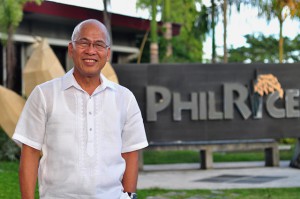In more than three years as PhilRice executive director, Dr. Eufemio T. Rasco, Jr. has stood with his conviction to swing rice R&D direction from the rice crop to the rice farmer. 
“When you focus on the rice farmer, you begin to realize that the rice environment is not only about rice. There are many things you can do in the rice environment with the rice farmers so that you can extricate them from poverty,” Rasco said.
During the turnover ceremony of PhilRice leadership, 3 February, Rasco reiterated the need to start using the rice farming environment as the unit of productivity analysis instead of the rice plant.
Rasco retired from government service as he turned 65 on 3 February 2015.
DA Assistant Secretary for Field Operations and Director of the National Rice and Corn Programs Edilberto M. De Luna assumed post as PhilRice officer-in-charge effective 3 February. The search for the new executive director is ongoing.
Summing up his term, Rasco said “PhilRice is probably the easiest organization to manage. With the dedicated and professional manpower you have here, it can run on auto-pilot and not crash.”
Rasco urged PhilRice staff members to pursue “the change that we have trodden together” – to continue advocating for agriculture-based biosystems in the rice farm.
Rasco and research at PhilRice
Rasco dedicated almost 4 decades of his career to public service.
During his stint as executive director, Rasco envisioned to transform rural communities into more productive and sustainable agri-business enterprises. He has always believed in exploring the potentials of the rice lands to augment rice farming income.
He institutionalized five new R&D programs to address the current and future challenges in the rice sector. These are Coping with climate change, High-value products from rice and its environment, Farming without fossil energy, Intensified rice-based agri-bio systems, and FutureRice. Each is geared toward a self-sufficient, sustainable, and competitive rice economy.
To operationalize these programs, Rasco led the creation of various centers that would help develop appropriate technologies for rice-based ecosystem. The Applied Biology Center for the Rice Environment aims to increase outputs and reduce inputs in rice farming and rice-based enterprises through applied biology.
Rasco also supported research studies on other sources of energy such as bioethanol and hybrid energy (e.g. wind/solar, biomass/solar) to develop an energy system for rice-based agriculture that is renewable, decentralized, and diversified.
“To him, farming without fossil energy is the scientific description for what is commonly called but misunderstood organic agriculture,” said PhilRice Deputy Executive Director for Research Dr. Manuel Jose C. Regalado.
Recognizing seeds as a critical input, Rasco also established the Genetics Resources Division to facilitate seed transfer and germplasm exchange. The Seed Technology Division, on the other hand, was established to ensure high seed quality of the newly-released rice varieties through compact demonstration.
Rasco and development at PhilRice
Rasco strengthened the promotion and adoption of research outputs through development programs. He conceptualized the Palayabangan 10-5 challenge to fast-track the search for technology that can increase production to 10t/ha at a cost of Php5/kg.
His term also birthed the National Year of Rice in 2013 to engage the public in the country’s bid for rice self-sufficiency.
As a follow through, Rasco advocated the Gusto Namin Milyonaryo Kayo campaign to push for rural transformation rather than mere technology transmission. He also supported youth engagement in agriculture through the Infomediary Campaign.
“PhilRice has three treasures [according to Rasco]: people, germplasm, and information. From these, rice R&D should eventually help rice-based farmers become rich,” Regalado said.
Organizational management
PhilRice also changed its organizational structure with the separation of research and development but with a continuum of functions. Rasco calls it RDDD or research, development, demonstration, and deployment.
“Research and development is done by our research arm while demonstration and deployment is done by the development group. We develop new technologies and create a show window of these technologies,” Rasco explained.
Rasco’s initiative to revamp the qualification and performance standards of PhilRice staff members led to a 700% increase in publication and various awards from 2011 to 2014.
He also redefined the mandate of the branch stations to serve as technology development centers or nuclei to facilitate technology deployment and services to surrounding communities.
Dr. Eduardo Jimmy P. Quilang, PhilRice deputy executive director for Development, described Rasco as a transformative, visionary, and innovative leader.
“He has been a very good mentor; although he does it subtly. You will just realize he has already taught you the ways to efficiently do your job,” Quilang said.
Pres. Benigno Aquino III appointed Rasco on secondment as the fourth Executive Director of PhilRice on 14 July 2011 in his concurrent capacity as professor in UP Mindanao.




